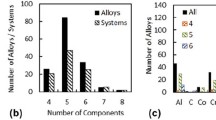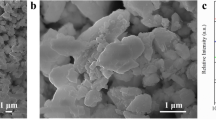Abstract
Ionic liquids have developed and been applied in lubricant field since 2001. Nevertheless, it is little known about novel dicationic ionic liquids for tribology applications in the past several years. In this paper, a sequence of novel dicationic ionic liquids based on 1,4-diazabicyclo[2.2.2]octane cations (DABCO) and different anions have been designed and identified. The structures of ILs were confirmed by Fourier transform infrared (FTIR) spectra, multinuclear (1H, 13C, 11B, 31P and 19F) magnetic resonance and mass spectrometry. The effects of anion type on thermal properties, wettability, kinematic viscosity and tribological properties were studied. It is found that all of these dicationic ionic liquids as additives exhibit excellent anti-wear and friction-reducing properties in PEG synthetic base oil under boundary lubrication conditions for steel-to-steel contact, which offers great potential for the highly efficient lubricant additives. Simultaneously, novel 1,4-diazabicyclo[2.2.2]octane cation offers an exceptional chance for the research and development of dicationic ionic liquids in various applications.
Similar content being viewed by others
References
Zhou Y, Qu J. Ionic liquids as lubricant additives: A review. ACS Appl Mater Interfaces, 2017, 9: 3209–3222
Amiril S A S, Rahim E A, Syahrullail S. A review on ionic liquids as sustainable lubricants in manufacturing and engineering: Recent research, performance, and applications. J Cleaner Production, 2017, 168: 1571–1589
Oster K, Jacquemin J, Hardacre C, et al. Further development of the predictive models for physical properties of pure ionic liquids: Thermal conductivity and heat capacity. J Chem ThermoDyn, 2018, 118: 1–15
Zhang D, Qu Y, Gong Y Y, et al. Physicochemical properties of [cnmim][thr] (n=3, 5, 6) amino acid ionic liquids. J Chem ThermoDyn, 2017, 115: 47–51
De Leo F, Cardiano P, De Carlo G, et al. Testing the antimicrobial properties of an upcoming “environmental-friendly” family of ionic liquids. J Mol Liquids, 2017, 248: 81–85
Iwasaki K, Yoshii K, Tsuda T, et al. Physicochemical properties of phenyltrifluoroborate-based room temperature ionic liquids. J Mol Liquids, 2017, 246: 236–243
Pillai P, Pal N, Mandal A. Synthesis, characterization, surface properties and micellization behaviour of imidazolium-based ionic liquids. J Surfact Deterg, 2017, 20: 1321–1335
Qiao K, Hagiwara H, Yokoyama C. Acidic ionic liquid modified silica gel as novel solid catalysts for esterification and nitration reactions. J Mol Catal A-Chem, 2006, 246: 65–69
Simonetti E, Carewska M, Di Carli M, et al. Towards improvement of the electrochemical properties of ionic liquid-containing polyethylene oxide-based electrolytes. Electrochim Acta, 2017, 235: 323–331
Drvaric Talian S, Bešter-Rogac M, Dominko R. The physicochemical properties of a [DEME][TFSI] ionic liquid-based electrolyte and their influence on the performance of lithium-sulfur batteries. Electrochim Acta, 2017, 252: 147–153
Tarkhanova I G, Anisimov A V, Buryak A K, et al. Immobilized ionic liquids based on molybdenum- and tungsten-containing heteropoly acids: Structure and catalytic properties in thiophene oxidation. Pet Chem, 2017, 57: 859–867
Al Kaisy G M J, Mutalib M I A, Leveque J M, et al. Novel low viscosity ammonium-based ionic liquids with carboxylate anions: Synthesis, characterization, and thermophysical properties. J Mol Liquids, 2017, 230: 565–573
Pejakovic V, Kronberger M, Kalin M. Influence of temperature on tribological behaviour of ionic liquids as lubricants and lubricant additives. Lubr Sci, 2014, 26: 107–115
Minami I. Ionic liquids in tribology. Molecules, 2009, 14: 2286–2305
Zhu L, Zhao Q, Wu X, et al. A novel phosphate ionic liquid plays dual role in synthetic ester oil: From synthetic catalyst to anti-wear additive. Tribol Int, 2016, 97: 192–199
Shah F U, Glavatskih S, MacFarlane D R, et al. Novel halogen-free chelated orthoborate–phosphonium ionic liquids: Synthesis and tribophysical properties. Phys Chem Chem Phys, 2011, 13: 12865–12873
Xiao H, Guo D, Liu S, et al. Film thickness of ionic liquids under high contact pressures as a function of alkyl chain length. Tribol Lett, 2010, 41: 471–477
Kawada S, Sato K, Watanabe S, et al. Lubricating property of cyanobased ionic liquids against hard materials. J Mech Sci Technol, 2017, 31: 5745–5750
Viesca J L, Mallada M T, Blanco D, et al. Lubrication performance of an ammonium cation-based ionic liquid used as an additive in a polar oil. Tribol Int, 2017, 116: 422–430
Dong R, Wen P, Zhang S, et al. The synthesis and tribological properties of dicarboxylic acid ionic liquids. Tribol Int, 2017, 114: 132–140
Blanco D, González R, Viesca J L, et al. Antifriction and antiwear properties of an ionic liquid with fluorine-containing anion used as lubricant additive. Tribol Lett, 2017, 65: 66
Wu J, Lu X, Feng X, et al. Halogen-free ionic liquids as excellent lubricants for PEEK-stainless steel contacts at elevated temperatures. Tribol Int, 2016, 104: 1–9
Hernández Battez A, Blanco D, Fernández-González A, et al. Friction, wear and tribofilm formation with a [NTf 2] anion-based ionic liquid as neat lubricant. Tribol Int, 2016, 103: 73–86
Cooper P K, Li H, Rutland M W, et al. Tribotronic control of friction in oil-based lubricants with ionic liquid additives. Phys Chem Chem Phys, 2016, 18: 23657–23662
Barnhill W C, Luo H, Meyer H M, et al. Tertiary and quaternary ammonium-phosphate ionic liquids as lubricant additives. Tribol Lett, 2016, 63: 22
Ye C, Liu W, Chen Y, et al. Room-temperature ionic liquids: A novel versatile lubricant. Chem Commun, 2001, 21: 2244–2245
Xu W, Wang L M, Nieman R A, et al. Ionic liquids of chelated orthoborates as model ionic glassformers. J Phys Chem B, 2003, 107: 11749–11756
Moosavi M, Khashei F, Sedghamiz E. Molecular dynamics simulation of geminal dicationic ionic liquids [Cn (mim)2 ][NTf2 ]2-structural and dynamical properties. Phys Chem Chem Phys, 2017, 20: 435–448
Anderson J L, Ding R, Ellern A, et al. Structure and properties of high stability geminal dicationic ionic liquids. J Am Chem Soc, 2005, 127: 593–604
Mahrova M, Pagano F, Pejakovic V, et al. Pyridinium based dicationic ionic liquids as base lubricants or lubricant additives. Tribol Int, 2015, 82: 245–254
Gusain R, Gupta P, Saran S, et al. Halogen-free bis(imidazolium)/bis (ammonium)-di[bis(salicylato)borate] ionic liquids as energy-efficient and environmentally friendly lubricant additives. ACS Appl Mater Interfaces, 2014, 6: 15318–15328
Gusain R, Bakshi P S, Panda S, et al. Physicochemical and tribophysical properties of trioctylalkylammonium bis(salicylato)borate (N888n-BScB) ionic liquids: Effect of alkyl chain length. Phys Chem Chem Phys, 2017, 19: 6433–6442
Lohar T, Kumbhar A, Barge M, et al. DABCO functionalized dicationic ionic liquid (DDIL): A novel green benchmark in multicomponent synthesis of heterocyclic scaffolds under sustainable reaction conditions. J Mol Liquids, 2016, 224: 1102–1108
Zhiltsova E P, Lukashenko S S, Pashirova T N, et al. Supramolecular catalytic systems based on 1, 4-diazabicyclo[2.2.2]octane, its alkylated quaternary derivatives, and lanthanum nitrate. Russ Chem Bull, 2015, 64: 2690–2696
Zhan S P, Duan H T, Hua M, et al. Studies of antioxidant performance of amine additives in lubricating oil using 3D-QSAR. Sci China Technol Sci, 2017, 60: 299–305
Li Y, Zhang S, Ding Q, et al. The corrosion and lubrication properties of 2-Mercaptobenzothiazole functionalized ionic liquids for bronze. Tribol Int, 2017, 114: 121–131
Amorim P M, Ferraria A M, Colaço R, et al. Imidazolium-based ionic liquids used as additives in the nanolubrication of silicon surfaces. Beilstein J Nanotechnol, 2017, 8: 1961–1971
Tang X W, Zhang C H, Wang Y, et al. Analysis of surface and subsurface of cold-rolled Al plate lubricated with water- or oil-based lubricants. Sci China Technol Sci, 2017, 60: 1407–1414
Sun Y F, Chai Z M, Lu X C, et al. A direct atomic layer deposition method for growth of ultra-thin lubricant tungsten disulfide films. Sci China Technol Sci, 2017, 60: 51–57
Beattie D A, Harmer-Bassell S L, Ho T T M, et al. Spectroscopic study of ionic liquid adsorption from solution onto gold. Phys Chem Chem Phys, 2015, 17: 4199–4209
Wu X, Liu J, Zhao Q, et al. In situ formed ionic liquids in polyol esters as high performance lubricants for steel/steel contacts at 300°C. ACS Sustain Chem Eng, 2015, 3: 2281–2290
Ali G, Rahman G, Chung K Y. Cobalt-doped pyrochlore-structured iron fluoride as a highly stable cathode material for lithium-ion batteries. Electrochim Acta, 2017, 238: 49–55
Yan J, Zeng X, van der Heide E, et al. The tribological performance and tribochemical analysis of novel borate esters as lubricant additives in rapeseed oil. Tribol Int, 2014, 71: 149–157
Zhang Y, Cai T, Shang W, et al. Environmental friendly polyisobutylene-based ionic liquid containing chelated orthoborate as lubricant additive: Synthesis, tribological properties and synergistic interactions with ZDDP in hydrocarbon oils. Tribol Int, 2017, 115: 297–306
Zhu L, Zhao G, Wang X. Investigation on three oil-miscible ionic liquids as antiwear additives for polyol esters at elevated temperature. Tribol Int, 2017, 109: 336–345
Qian X, Ren M, Zhu Y, et al. Visible light assisted heterogeneous fenton-like degradation of organic pollutant via a-FeOOH/mesoporous carbon composites. Environ Sci Technol, 2017, 51: 3993–4000
Author information
Authors and Affiliations
Corresponding author
Electronic supplementary material
11431_2018_9384_MOESM1_ESM.doc
Synthesis, characterization and tribological evaluation of novel 1, 4-diazabicyclo[2.2.2]octane based dicationic ionic liquids as efficient antiwear lubricant additives
Rights and permissions
About this article
Cite this article
Zhao, L., Cai, T., Zhang, Y. et al. Synthesis, characterization and tribological evaluation of novel 1,4-diazabicyclo[2.2.2]octane based dicationic ionic liquids as efficient antiwear lubricant additives. Sci. China Technol. Sci. 62, 252–262 (2019). https://doi.org/10.1007/s11431-018-9384-2
Received:
Accepted:
Published:
Issue Date:
DOI: https://doi.org/10.1007/s11431-018-9384-2




